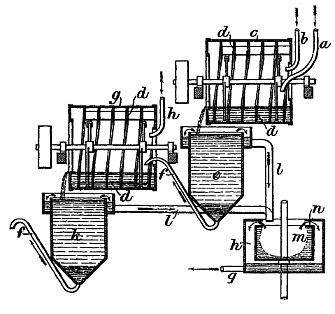Date of Application, 18th Oct., 1898
Complete Specification Left, 15th Aug., 1899 - Accepted, 18th Jan., 1900
Abstract.
Elmore, F. E. Oct. 18. Treating ores; washing ores. Consists in
separating the metallic from the rocky constituents of pulverized ores
by
mixing with water and then bringing the mixture into contact with thick
oil. The oil entraps the metallic constituents, which are afterwards
separated, and the rocky constituents pass away with the water. The
Figure shows a form of the apparatus. The mixture of pulverized ore and
water, supplied by a pipe, and the oil, supplied by the pipe b, flow
into a rotating drum c
provided with helical ribs d
which extend from
end to end. The spaces between these ribs are divided into cells by
equidistant blades. The ore, oil, &c. are discharged from the end
of the drum into a vessel e,
in which the rocky constituents subside,
while the oil with the metallic constituents floats above. The lowest
layer is drawn away as tailings and passes through a pipe f to another
drum g, and the process is
repeated until the whole of the mineral
constituents are separated. The oil and the contained mineral matter
are led by pipes l to a
rotating drum m containing
water and subjected
to centrifugal action. The mineral matter passes into the water, and
the oil flows out into the casing h,
and thence is pumped up through a
pipe g to a cistern,
preferably partially exhausted of air, and may be
used over again. Instead of the separation by centrifugal action, the
oil may be thinned by heating or mingling it with solvents such as
benzoline, and afterwards left for subsidence or passed through a
filter press.



